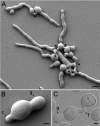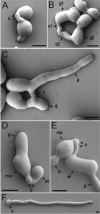Cell biology of conidial anastomosis tubes in Neurospora crassa
- PMID: 15879525
- PMCID: PMC1140100
- DOI: 10.1128/EC.4.5.911-919.2005
Cell biology of conidial anastomosis tubes in Neurospora crassa
Abstract
Although hyphal fusion has been well documented in mature colonies of filamentous fungi, it has been little studied during colony establishment. Here we show that specialized hyphae, called conidial anastomosis tubes (CATs), are produced by all types of conidia and by conidial germ tubes of Neurospora crassa. The CAT is shown to be a cellular element that is morphologically and physiologically distinct from a germ tube and under separate genetic control. In contrast to germ tubes, CATs are thinner, shorter, lack branches, exhibit determinate growth, and home toward each other. Evidence for an extracellular CAT inducer derived from conidia was obtained because CAT formation was reduced at low conidial concentrations. A cr-1 mutant lacking cyclic AMP (cAMP) produced CATs, indicating that the inducer is not cAMP. Evidence that the transduction of the CAT inducer signal involves a putative transmembrane protein (HAM-2) and the MAK-2 and NRC-1 proteins of a mitogen-activated protein kinase signaling pathway was obtained because ham-2, mak-2, and nrc-1 mutants lacked CATs. Optical tweezers were used in a novel experimental assay to micromanipulate whole conidia and germlings to analyze chemoattraction between CATs during homing. Strains of the same and opposite mating type were shown to home toward each other. The cr-1 mutant also underwent normal homing, indicating that cAMP is not the chemoattractant. ham-2, mak-2, and nrc-1 macroconidia did not attract CATs of the wild type. Fusion between CATs of opposite mating types was partially inhibited, providing evidence of non-self-recognition prior to fusion. Microtubules and nuclei passed through fused CATs.
Figures







References
-
- Ashkin, A., J. M. Dziedzic, and T. Yamane. 1987. Optical trapping and manipulation of single cells using infrared laser beams. Nature 330:769-771. - PubMed
-
- Aubrey, L., and R. Firtel. 1999. Integration of signalling networks that regulate Dictyostelium differentiation. Annu. Rev. Cell Dev. Biol. 15:469-517. - PubMed
-
- Bistis, G. N. 1981. Chemotropic interactions between trichogynes and conidia of opposite mating-type in Neurospora crassa. Mycologia 73:959-975.
-
- Bobrovicz, P., R. Pawlak A. Corea, D. Bell-Pedersen, and D. J. Ebbole. 2002. The Neurospora crassa pheromone precursor genes are regulated by the mating type locus and the circadian clock. Mol. Microbiol. 45:795-804. - PubMed
-
- Bölker, M., M. Urban, and R. Kahmann. 1992. The a mating type locus of U. maydis specified cell signaling components. Cell 68:441-450. - PubMed
Publication types
MeSH terms
Substances
LinkOut - more resources
Full Text Sources
Miscellaneous

